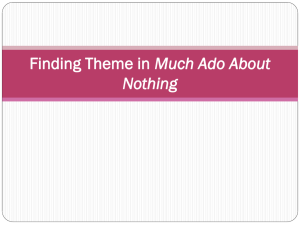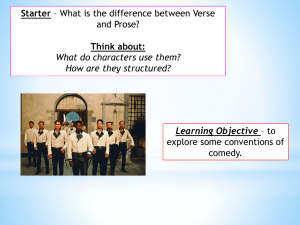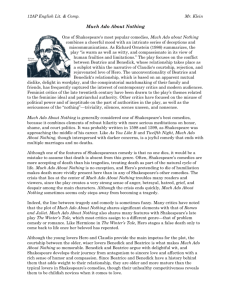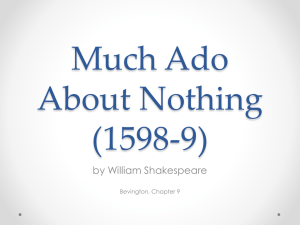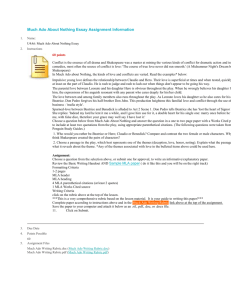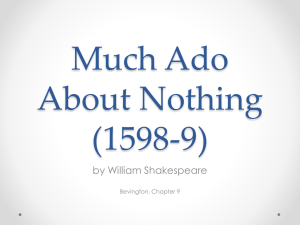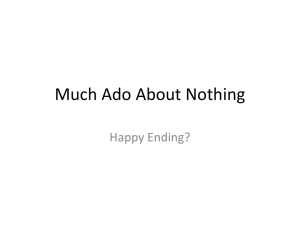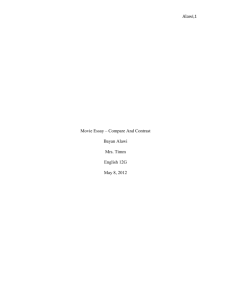Much Ado About Nothing: Prose, Verse & Euphuism Analysis
advertisement
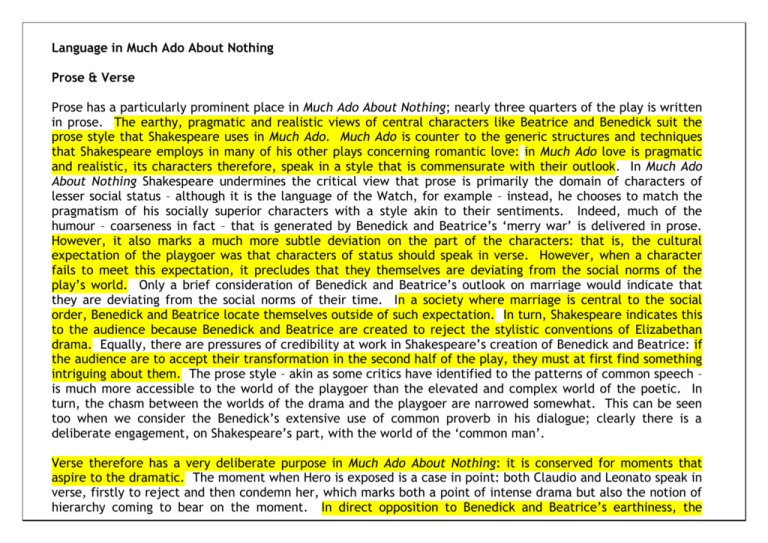
Language in Much Ado About Nothing Prose & Verse Prose has a particularly prominent place in Much Ado About Nothing; nearly three quarters of the play is written in prose. The earthy, pragmatic and realistic views of central characters like Beatrice and Benedick suit the prose style that Shakespeare uses in Much Ado. Much Ado is counter to the generic structures and techniques that Shakespeare employs in many of his other plays concerning romantic love: in Much Ado love is pragmatic and realistic, its characters therefore, speak in a style that is commensurate with their outlook. In Much Ado About Nothing Shakespeare undermines the critical view that prose is primarily the domain of characters of lesser social status – although it is the language of the Watch, for example – instead, he chooses to match the pragmatism of his socially superior characters with a style akin to their sentiments. Indeed, much of the humour – coarseness in fact – that is generated by Benedick and Beatrice’s ‘merry war’ is delivered in prose. However, it also marks a much more subtle deviation on the part of the characters: that is, the cultural expectation of the playgoer was that characters of status should speak in verse. However, when a character fails to meet this expectation, it precludes that they themselves are deviating from the social norms of the play’s world. Only a brief consideration of Benedick and Beatrice’s outlook on marriage would indicate that they are deviating from the social norms of their time. In a society where marriage is central to the social order, Benedick and Beatrice locate themselves outside of such expectation. In turn, Shakespeare indicates this to the audience because Benedick and Beatrice are created to reject the stylistic conventions of Elizabethan drama. Equally, there are pressures of credibility at work in Shakespeare’s creation of Benedick and Beatrice: if the audience are to accept their transformation in the second half of the play, they must at first find something intriguing about them. The prose style – akin as some critics have identified to the patterns of common speech – is much more accessible to the world of the playgoer than the elevated and complex world of the poetic. In turn, the chasm between the worlds of the drama and the playgoer are narrowed somewhat. This can be seen too when we consider the Benedick’s extensive use of common proverb in his dialogue; clearly there is a deliberate engagement, on Shakespeare’s part, with the world of the ‘common man’. Verse therefore has a very deliberate purpose in Much Ado About Nothing: it is conserved for moments that aspire to the dramatic. The moment when Hero is exposed is a case in point: both Claudio and Leonato speak in verse, firstly to reject and then condemn her, which marks both a point of intense drama but also the notion of hierarchy coming to bear on the moment. In direct opposition to Benedick and Beatrice’s earthiness, the moment when Hero is exposed demands that the characters – or more specifically, the men – impose order and control over the moral chaos that has broken out. However, this does not follow the simple logic that prose is the preserve of higher order characters; instead, it highlights it as a tool of power and control in the play. Logically, both Claudio – ‘O, what men dare do! – and Leonato – ‘Why doth not every earthly thing/Cry shame upon her? – are bereft of understanding following the accusations made against Hero. In turn, Shakespeare provides them with a linguistic device to regain control: verse. The eloquence of the verse crystallises the raw emotion of both men – though reprehensible it might be – and, in turn, centres them for the audience as the dramatic authorities on the stage at this point. Consequently, where the prose helps the audience to relate to the pragmatism of Benedick and Beatrice earlier in the play; here the verse creates a suitable distance for the magnitude of the events to have a defining impact on the other characters, and, the audience. There is a sense, in turn, of a society rocked to its core by the revelations that have just played out on stage. That the two central males – Claudio and Leonato – should use verse alludes to the real crisis here: that a woman has confronted – theoretically at least – the men with a proposition that is at odds with the moral absolutism that they live by. In order to establish order and authority once more, we see the characters revert to verse because of the dramatic weight that it carries in the understanding of the theatre goer. The idea of male authority and language is central to Much Ado About Nothing. The play is concerned with modes of expression and how they directly reflect the rank, social position, moral perspectives and dramatic hierarchy. Much Ado, therefore, is arguably an experiment in prose and verse styles: it enables Shakespeare to explore the politics, morals and virtues of Messina by imbuing his characters with permanently fluctuating levels of power and status. Euphuism "Euphues" is Greek and means "graceful, witty". Shakespeare’s prose in Much Ado About Nothing draws on a specific style and construction called Euphuism. This is a preciously ornate and sophisticated style of writing that was fashionable in the 1580s, especially in the Elizabethan Court but never previously or subsequently This style of speech makes use of antitheses, alliterations, repetitions, rhetorical questions Classical learning and remote knowledge of all kinds were displayed. The style comes from the works of John Lyle (1553-1606) titled Euphues: The Anatomy of Wit (1578) and Euphues and his England (1580). In both texts, Lyle explores the fashionable traditions of England in a style that is deliberately mannered and elevated. The euphuistic sentence followed principles of balance and antithesis. John Lyly set up three basic structural principles: 1. phrases of equal length that appear in succession; balanced sentences 2. the balance of key verbal elements in successive sentences; antithesis 3. the correspondence of sounds and syllables, especially between words that are already balanced against each other. Puns, alliteration, repetition The characteristics of Euphuism Euphuism – taken from the name of Lyle’s character Euphues meaning ‘graceful’ and ‘witty’ in Greek – is constructed using very particular rhetorical techniques. Antithetical balance – sentences are comprised of two matched clauses which have a contrasting meaning. Oppositions – the contrasts in the sentences are often denoted by phonological patterning like alliteration or assonance, and by words, which although different in meaning, are similar in spelling or pronunciation. Conflicting Meaning – the conflict in meanings are generated in this style because of the way that puns are used; references to common proverbials and natural history, for example, where there is some play-on the duality of meaning. Aural Ornateness – the balance and antithesis of Euphuism gives rise to a distinctive tone in its delivery. Prose Only – Euphuism is a prose form only and cannot be discerned in verse. Read the extract below, which is the initial exchange of hostility between Benedick and Beatrice in Act I, Scene I. Antithesis examples: To err is human to forgive divine She wanted to fall in love, he wanted a good time” "One small step for a man, one giant leap for all mankind." Neil Armstrong "We must learn to live together as brothers or perish together as fools." (Martin Luther King, Jr., speech at St. Louis, 1964) My only love sprung from my only hate" (Juliet) BENEDICK What, my dear Lady Disdain! Are you yet living? BEATRICE Is it possible Disdain should die, while she hath such Disdain: Scorn, despise, contempt meet food to feed it as Signor Benedick? Courtesy itself meet = ideal must convert to disdain, if you come in her presence. BENEDICK Then is courtesy a turncoat. But it is certain I am loved of all ladies, only you excepted; and I would I could find in my heart that I had not a hard heart, for truly, I love none. BEATRICE A dear happiness to women – they would else have been troubled with a pernicious suitor! I thank God and my cold blood, I am of your humour for that: I had rather a pernicious: harmful / annoying lover I am of your humour(temperament) for that: agree hear my dog bark at a crow, than a man swear he loves me. (clearly designed to sting but also be enjoyed by the audience) BENEDICK God keep your ladyship still in that mind! So some gentleman or other shall ‘scape a predestinate scratched predestinate: inevitable face. BEATRICE Scratching could not make it worse, an ‘twere such a face as yours were. BENEDICK Well, you are a rare parrot-teacher. BEATRICE A bird of my tongue is better than a beast of yours. BENEDICK I would my horse had the speed of your tongue, and so good a continuer. But keep your way, o’God’s name; I Parrot teacher: repeater of empty phrases continuer ability to continue / stamina have done. BEATRICE You always end with a jade’s trick; I know you of old. Jade: like a horse slipping away from its collar she gets away from her wit (I.i.112-39) Annotate the speech trying to identify each of the following elements of the Euphuistic style: Antithetical Balance; antithesis Oppositions; contrasts Conflicting Meaning; Aural Ornateness Think about why Shakespeare allows both Benedick and Beatrice to use the Euphuistic style; bear in mind that Beatrice is a female. Consider the subject matter than Benedick and Beatrice are discussing; why do you think that Shakespeare has matched this content with the Euphuistic style? Given that some critics of the style refer to it as ‘overly ornate’ or ‘artificial’ – how does this affect your understanding of why Shakespeare uses the Euphuistic style? Consider the potential irony of Shakespeare’s use of Euphuism in these passages given that both of these character polarise themselves from given social norms in Messina. Finally, who do you think ‘wins’ this duel? Songs in Much Ado About Nothing Songs play a central role in the linguistic patterning of the play. Throughout the play, songs are used to foreground both the emotional and ideological tone of the events that take place. Like the use of verse and prose, the songs defy their conventional purpose: often they create a foreboding sense of what is to come rather than offer a primarily decorative quality. Complete the chart below for each of the songs in Much Ado About Nothing giving consideration to their subject matter, thematic content, and impact on the scene. The Comic Genre Unlike ‘tragedy’ for which we have Aristotle’s Poetics upon which to base our understanding of the genre, comedy lacks a seminal text from which its characteristics can be drawn. Instead, our understanding of how comedy is constructed in a structural sense comes from the work of Donatus and Euanthius. Donatus Structure of Comedy In his text, On Comedy, Donatus points to four distinct elements that combine to create the comic genre. 1. The Prologue – ‘the first speech’ 2. The Protasis – ‘the first action of the story, where the plot of the story is explained, although some is held back from the audience to arouse suspense among the audience. 3. The Epitasis – ‘the complication of the story, by excellence of which its elements are intertwined. 4. The Catastrophe – ‘the unravelling of the story through which the outcome is demonstrated’ - On Comedy: 47-48. Euanthius’ Refinement of Donatus’ Structure In On Drama, Euanthius develops the structural foundations of ‘comedy’ as offered by Donatus. 1. The Prologue – ‘a kind of preface to the drama’ 2. Epistasis – ‘the development and the enlargement of the conflict and, as it were, the knot of all error’ 3. Catastrophe – ‘the resolution of the course of events so that there is a happy ending which is made evident to all by the recognition of past events. - On Drama: 45. By the time we arrive at Euanthius refinement, a template exists against which we can identify the central structural elements of the ‘comedy’ in terms of genre. Indeed, the few ideas that Aristotle offers in Poetics, are here superseded. In addition, as with all generic conventions, the structure is open to subversion at the playwrights will. Use the chart below to identify the four elements of ‘comedy’ in Much Ado About Nothing Give a definition of each term underneath its title. Element of ‘comedy’ The Prologue The Prostasis The Epitasis The Catastrophe Action/Event in Much Ado About Nothing Explanation of how action/event equates to the element of ‘comedy’ Comedy: Morality & Conflict Comedy, as demonstrated by the critical theories of Donatus and Euanthius, enjoys a long and complex history. However, its cultural position has often been questioned and threatened. The central tensions at the core of this history are questions of morality and laughter. In The Republic, Plato identifies: in comic representations, or for that matter in private talk, you take an intense pleasure from buffooneries that you would blush to practice yourself, and do not detest them yourself. Inherent in Plato’s reading of comedy is the notion that what man find’s amusing in artifice is precisely that which he abhors in reality. In turn a moral conflict arises: Plato, it would appear seems to question the moral validity of laughter in a societal sense when its object is precisely that which society should repudiate. Consequently, the place of laughter in society is problematised. Central to this problem is that critics of theatre feared the social effects of presenting behaviours that are counter-intuitive to society. This illuminates the reader – or playgoer – of comedy to two important things: first, that which is humorous is often counter to the virtuous aspirations of society; second, that when we laugh at this we derive a pleasure from it which in turn perpetuates representations of this type. In turn, the fears of the critics begin to materialise: that which is at first artifice becomes the norm. That is, the gradual increase in entertainments which are funny in this way become more common and the inherent behaviours become almost acceptable. The tension, therefore, becomes clear: many of comedy’s early audiences – and critics – were absorbed by a tension between what is ‘funny’ and what it was morally acceptable to be amused by. Philip Sydney, in The Defence of Poetry, supposes a problem inherent in the comic genre. In a way similar to Plato, Sydney argues that contemporary dramatists defile decorum and generic form. However, though it may appear that Sydney locates the argument in generic terms, his concern is centrally a moral one. Sydney writes : all their plays be neither right tragedies, nor right comedies, mingling kings and clowns, not because the matter so carrieth it…so as neither the admiration and commiseration, nor the right sportfulness, is by their mongrel tragic-comedy obstainde. The Defence of Poetry: 67. Thus the debate moves forward: while initially the tensions concerned ‘the comic’ and its societal implications, now the focus moves to the issue of genre. There still remains, however, a relationship between society, genre and the comic: the blend of kings and clowns is a replication of the barriers the critics consider to have been defiled by the comic genre. Beneath the surface of Sydney’s complaint about the interconnectedness between kings and clowns is an argument similar to Plato’s: comedy supposes situations that counter the organising principles and codes upon which society operates. In turn, comedy represents a threat to the established orders of the societies in which it is performed. Shakespeare – one such playwright whose plays were ‘neither right tragedies, nor right comedies’ – exercises the same dramatic abandonment with social class as Sydney finds distasteful. His plays juxtapose the rich and the poor; the virtuous and the dishonourable, and the king with the clown. What the critics of the time appear to find so dangerous is two fold: first, that such polarised groups might be seen to fraternise in drama; second, that through the fictional events of these interactions an audience might derive humour, for example.
